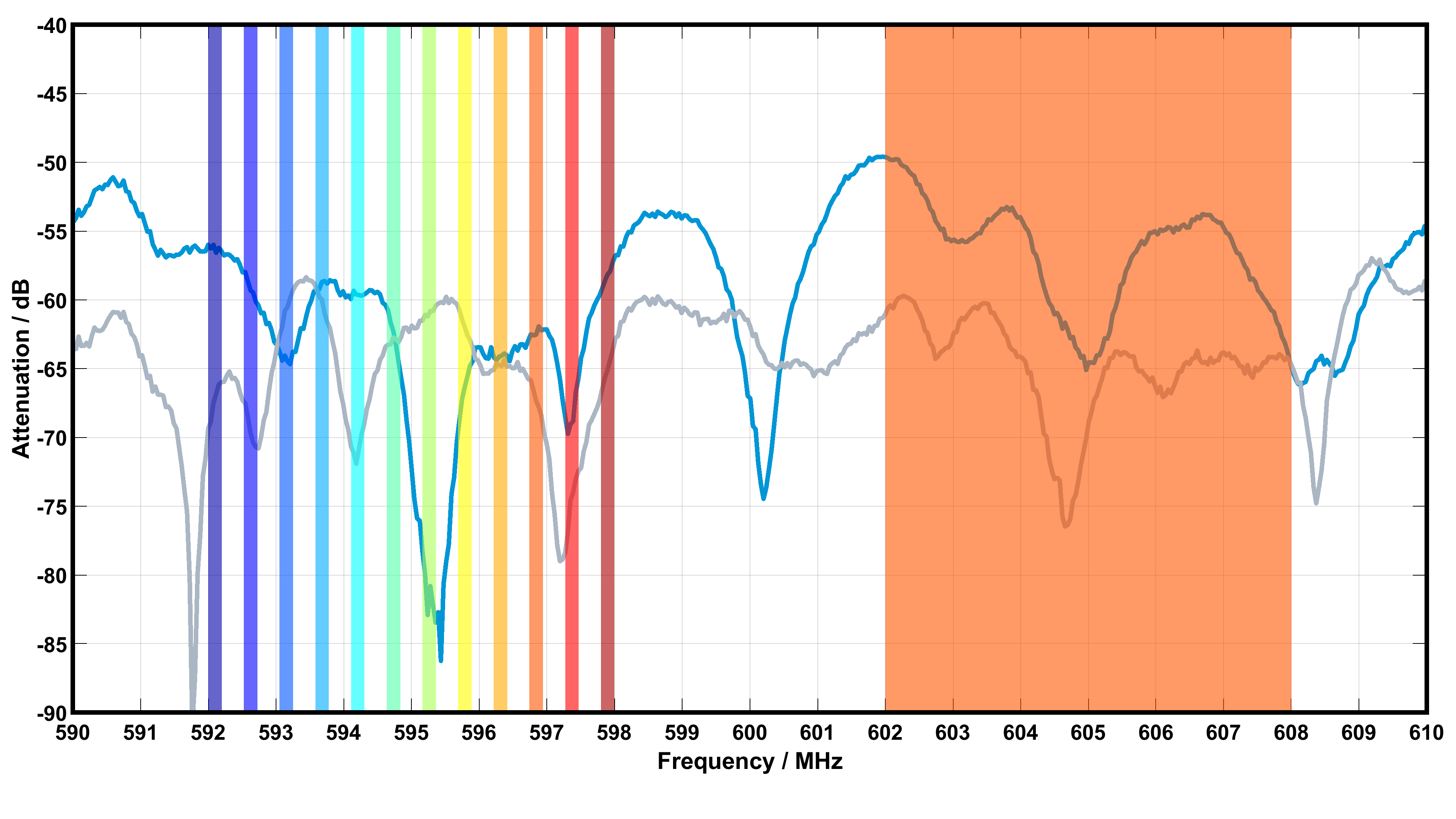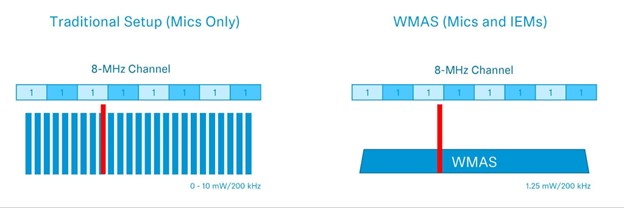Welcome WMAS
Here's how this new wireless mic technology is poised to impact the Pro AV industry.

CORRECTIONS AND LINKS

A new wireless microphone technology is on the way: Wireless Multichannel Audio Systems (WMAS). Approved by the Federal Communications Commission earlier this year, it's designed to allow more mics to operate in the available spectrum while providing greater interference protection. But how does it work and how will it impact the Pro AV industry? To get a technical perspective, SCN reached out to Joe Ciaudelli, director of spectrum and innovation for Sennheiser.
SCN: Technically speaking, what is WMAS?
Joe Ciaudelli: WMAS is a technology for large wireless microphone configurations. It’s a synthesis of broadband techniques (OFDM, TDMA, and TDD) that uses custom components to meet the stringent requirements of professional wireless audio transmission.

Today’s wireless audio technology relies on narrowband radio frequency (RF) solutions, with each audio channel utilizing one transmitter that sends its signal to a mating receiver unit. In this link-based approach, each audio channel operates on a unique narrowband carrier frequency, so 50 different narrowband frequencies need to be coordinated for a 50-channel mic setup. Alternatively, broadband wireless technology is a system-based, networked approach, meaning many mobile devices are linked with a 1 RU base station.
Now, all audio channels are transmitted using a single broadband RF channel with a bandwidth of 6 or 8 MHz, which is the bandwidth of a TV channel. The audio engineer simply uses the WMAS scan feature and selects a carrier frequency for the broadband RF channel (a vacant TV channel) to be configured, and the system will coordinate itself, with the quality and range that the engineer chooses for the individual audio devices.
SCN: Why is WMAS important or needed?
A daily selection of the top stories for AV integrators, resellers and consultants. Sign up below.
JC: In 2010, the FCC designated certain RF bands solely for use by broadband mobile providers. As a result, the live event industry has been facing increasing challenges with the limited availability of RF spectrum. The quantity and complexity of large and mega-events is steadily increasing, as is the associated demand for radio spectrum.
Securing enough spectrum for these big events is increasingly causing problems for engineers and event organizers, especially with outdoor events. WMAS technology will reshape wireless audio transmission in multi-channel applications for big live events, houses of worship, theaters, broadcast studios, sporting events, and wherever many audio channels are required.
Sennheiser’s implementation of WMAS is a bi-directional wireless broadband technology, which combines microphones, in-ears, and remote control in just one broadband RF channel. WMAS solves many common struggles for sound engineers, including RF fading and dropouts, while maximizing the increasingly scarce frequency resources available across the United States.
These forthcoming solutions will enable a single bodypack to support a wireless mic and in-ear monitor for artists simultaneously. WMAS will free up space backstage at events, taking away the need for large racks of receivers and transmitters—in a 1 RU space, the base station would feasibly handle 32 inputs and 32 outputs. Live audio engineers and frequency coordinators will benefit from additional control, less clutter, easier frequency coordination, and negligible RF fading, among many other advantages.
WMAS solves many common struggles for sound engineers, including RF fading and dropouts, while maximizing the increasingly scarce frequency resources available across the United States.
Additionally, Sennheiser’s WMAS will operate with the transmit power of a single conventional wireless microphone (approximately 50 mW), regardless of the number of audio channels. Within the capacity limit of the system, there will no longer be any scaling of the total transmit power by the number of devices used.
Further, this transmission power will be distributed over the entire RF broadband channel, so the spectral power density is lowered exponentially. This low spectral power density means that an RF channel can be reused more easily because the required separation distance between systems using the same RF channel is reduced considerably. For example, this would be an asset in multi-studio broadcast production facilities, school campuses, theme parks, or on the different stages of a spacious festival site.
SCN: How long has WMAS been in development and when was it approved?
JC: Sennheiser started the development of WMAS more than 10 years ago. In August 2018, Sennheiser filed a Petition for Rulemaking with the FCC requesting a modification in the bandwidth limit specified for wireless microphones. At that time, Sennheiser demonstrated a prototype system to the FCC’s Office of Engineering and Technology (OET). During the past five-and-a-half years, the FCC monitored further developments of WMAS technology and concluded that it justified the requested rule change. In February, the FCC approved a change in its regulation that now permits the operation of WMAS in the United States.
[AV Technology Manager’s Guide to Audio 2024]
SCN: How many companies were involved in its development?
JC: Sennheiser was the first to demonstrate proof of concept. One major competitor has contributed to the development of the WMAS technical standards. In the long term, we predict other manufacturers will develop systems and competition will be rigorous.
SCN: How is this better than current wireless mic/audio systems?
JC: There are many advantages compared to conventional wireless microphone systems. WMAS offers higher spectral efficiency—the ability to transmit more audio channels within a limited block of radio frequency (RF) spectrum. It’s more robust against dropouts. It has greater interference protection than other wireless services that share the same spectrum. You can use the same RF channel to operate in-ear monitors (IEM) and your other non-IEM channels (handhelds and body packs), which can cause issues with conventional narrowband systems. Plus, it saves a lot of rack space.
Initially, the goal of Sennheiser’s WMAS developers was to solve the problem of RF fading, the natural enemy of any wireless audio transmission. A mic transmitter propagates in an omnidirectional fashion. Part of the signal will reach the receiver antenna via a direct path. A portion of the transmission is likely to reflect off obstacles, such as a wall, floor, or ceiling. The reflected signal will arrive at your receiving antenna with a time delay that can significantly reduce the direct signal due to phase cancellation, causing dropouts.

Using WMAS technology, Spectera greatly reduces wireless system complexity, while considerably increasing capability, enabling time-saving workflows and offering full remote control and monitoring, including permanent spectrum sensing. The wideband digital wireless ecosystem features bidirectional bodypacks that manage both digital IEM/IFB and mic/line signals simultaneously, while the Base Station offers 32 I/O in a 1 RU. The solution is remarkably resistant to RF fading and allows for flexible use of the wideband RF channel with a latency down to 0.7 ms. The system also features the DAD Antenna, a transceiving antenna that manages mic/line signals, IEM signals, and control data at the same time, as well as LinkDesk software for Mac or PC that provides remote control and monitoring. All units help in continuously sensing the spectrum, meaning they scan for potential interference from other RF sources.
As research progressed, other advantages of broadband transmission were explored and developed, such as improved spectral efficiency, the easier reuse of an RF channel allowing denser deployments, and the ability for the operator to fine-tune critical parameters such audio fidelity, latency, and operating range of each audio channel.
At the same time, the wireless spectrum, particularly in the United States, has become an extremely limited resource for wireless microphone operators. WMAS technology also enables us to maximize the available spectrum by increasing both channel density and performance when compared to narrowband systems.
SCN: How does WMAS handle interference?
JC: Sennheiser’s WMAS technology implementation will offer constant scan functionality even during operation. All WMAS devices, be they mobile devices or stationary antennas, continuously monitor and measure the used RF spectrum (distributed spectrum sensing). This data is used to report detected interference to the operator and help them react dynamically to the situation. Field tests have shown that WMAS can tolerate an interfering narrowband signal (in some cases multiple interferers). This will give the operator crew at a live event enough time to track the source of interference and have it switched off.

If interference in the allocated TV channel is significant—maybe several interferers are active in this particular RF channel—and it may not be possible to maintain operation, the RF channel can be changed within seconds. Mobile devices do not need to be manually retuned. They will initiate a brief search, and then detect the relocated carrier from the base station. This will cause a short audio interruption of a few seconds, which is nothing if you consider how much time it would take to reprogram several narrowband receivers and associated transmitters.
SCN: Does WMAS have security features?
JC: The WMAS technology developed by Sennheiser is connection-oriented. This means that a mobile device, such as a microphone transmitter or in-ear receiver, establishes a connection to the central rack mount unit, which we'll call pairing. When a mobile device is paired to the central unit, an encryption key is exchanged. Then it can be coordinated using a permanent remote control channel within the same bidirectional RF channel that is used for audio transmission.
This implies that using a second receiver for listening in on the same RF signal (which is often done today as a sort of safety net) will not be possible anymore. However, it is worth noting that this option will also disappear for legacy narrowband wireless audio systems, as a regulatory requirement to encrypt personal data such as audio will be mandatory in the EU starting in 2025.
[Product Review: Sennheiser Keeps It Simple]
SCN: Does WMAS mean that other wireless systems will be phased out?
JC: No. WMAS is targeted for large multichannel operations. Sennheiser will still offer traditional narrowband systems to serve other applications.
SCN: Can you use current wireless mics with WMAS?
JC: Both types of transmission can coexist, but they should be operated on different RF channels if co-located. In other words, the same guidelines for frequency band planning apply as today.

Mark J. Pescatore, Ph.D., has been the content director of Systems Contractor News since 2021. During his career, he's hosted and programmed two ongoing regional industry trade shows (including Future B2B's AV/IT Summit), produced and hosted podcasts and webinars focused on the professional video marketplace, taught more than a dozen college communication courses, co-authored the book Working with HDV, and co-edited two editions of The Guide to Digital Television.
